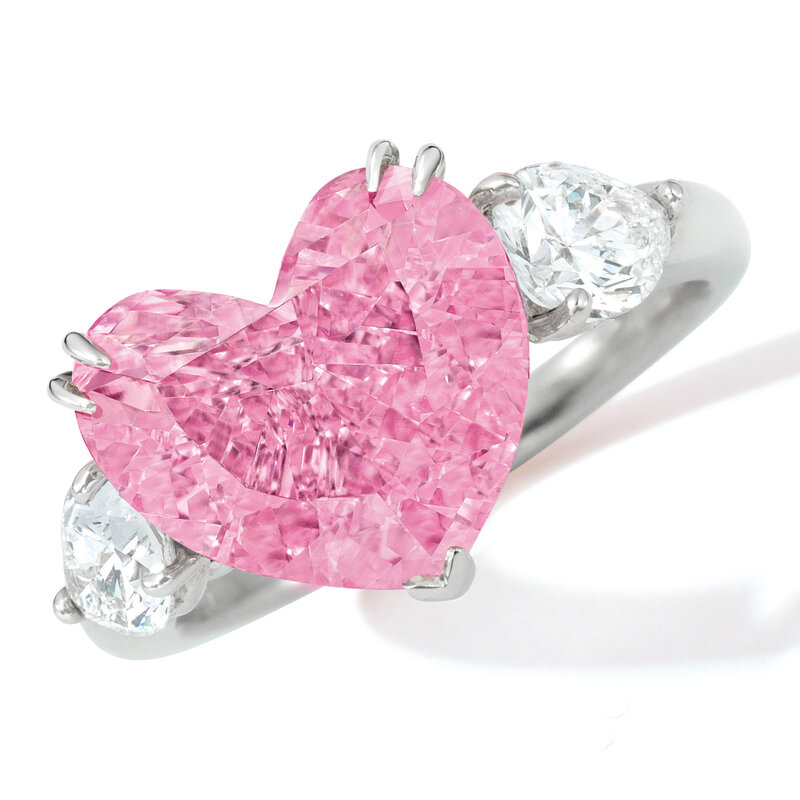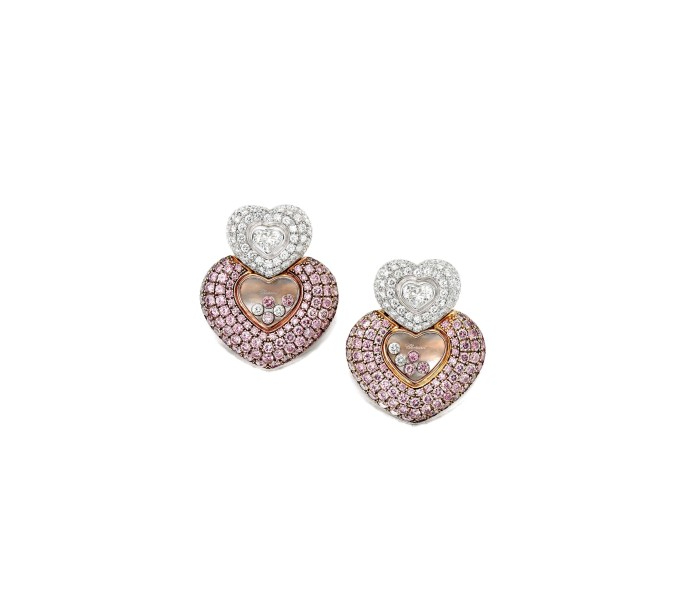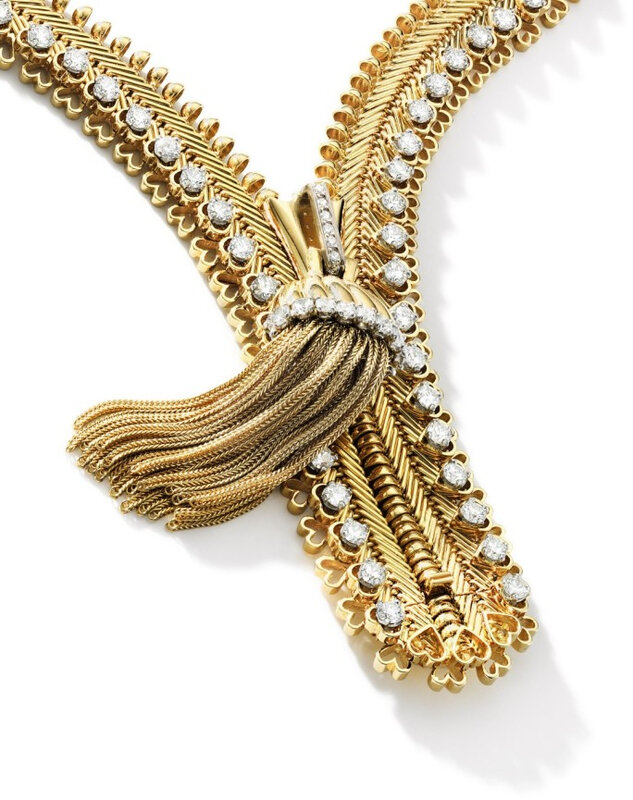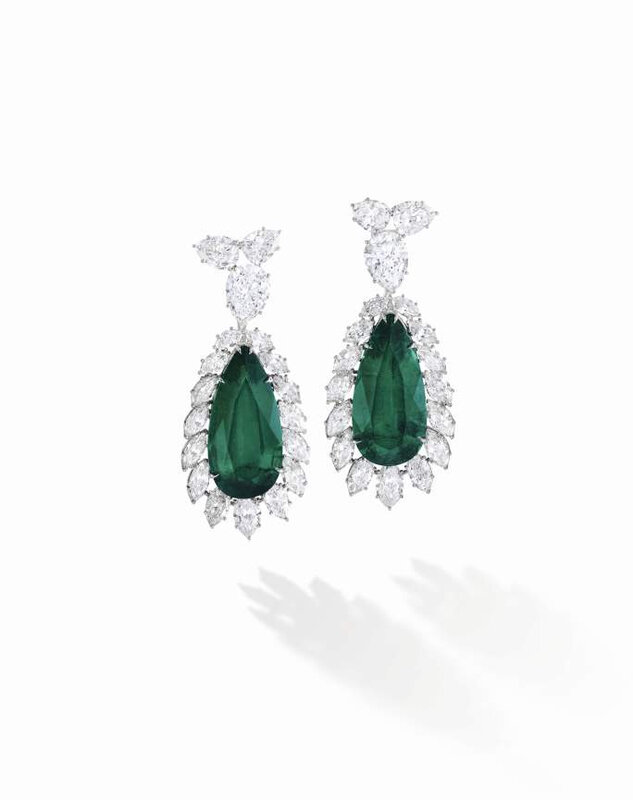Two Fancy Vivid heart-shaped rings to lead Sotheby's HK Magnificent Jewels live auction
(Above top) 4.49 carat Fancy Vivid Pink diamond, Internally Flawless. Estimate HK$ 58 – 68 million / US$7.5 – 8.8 million (Above bottom) 5.04 carat Fancy Vivid Blue Diamond Ring, Type IIb. Estimate HK$ 60 – 75 million / US$7.7 – 9.7 million. Courtesy Sotheby's.
HONG KONG.- Hot on the heels of its three consecutive 100%-sold online jewellery sales over the past two months, Sotheby’s Hong Kong will present Magnificent Jewels on 10 July 2020 at Hong Kong Convention and Exhibition Centre, which marks the return of live jewellery auctions in Asia.
Featuring over 200 lots, Magnificent Jewels will present a sophisticated curation of world class gemstones and statement signed jewels, led by a pair of exceptionally rare Fancy Vivid colored diamond rings (to be offered separately) - a Fancy Vivid Pink and a Fancy Vivid Blue weighing 4.49 carat and 5.04 carat respectively, both cut into charming heart shapes.
Iconic creations from luxury houses include a glamorous pair of Colombian Emerald and Diamond Earrings from Harry Winston (HK$12,000,000 – 15,000,000 / US$1,550,000 – 1,940,000), the famed ‘Zip’ necklace from Van Cleef & Arpels (HK$2,400,000 – 3,500,000 / US$310,000 – 451,000), an art deco brooch by Cartier from its famed Tutti Frutti series (HK$1,200,000 – 1,600,000 / US$155,000 – 207,000) as well as an eclectic array of Panthère designs from the brand that suits every occasion.
Celebrating the revival of jadeite to the market, the sale also features a selection of the finest jadeite jewellery with gemstone quality that meets world-class standards and timeless design that surpasses cultural boundaries.
“Our recent success with online sales clearly reflects the resilience of the jewellery auction market, and a strong appetite for top quality jewels in Asia. This much anticipated live auction of Magnificent Jewels will bring a diverse offering of jewellery, from the hottest colour diamonds, the most sought-after iconic designs, to the finest jadeites that are increasingly popular with collectors around the world. We look forward to welcoming our clients in Hong Kong this July and engaging with collectors worldwide via our digital innovations.” - Wenhao Yu, Deputy Chairman, Jewellery, Sotheby's Asia
JEWELS OF HEART
A symbol of love and affection, the shape of heart is an embodiment of strong emotions, and among the rarest and most difficult shapes to cut for diamonds.
Leading this season’s sale is a pair of exceptionally rare Fancy Vivid colored diamond rings (to be offered separately) that comes in the shape of heart – a 5.04 carat Fancy Vivid Blue Diamond Ring, Type IIb (Est. HK$60,000,000 – 75,000,000 / US$7,700,000 – 9,700,000), and a 4.49 carat Fancy Vivid Pink diamond, Internally Flawless (est. HK$58,000,000 – 68,000,000 / US$7,500,000 – 8,800,000).
Lot 1806. 5.04 carat Fancy Vivid Blue Diamond Ring, Type IIb. Estimate HK$ 60 – 75 million / US$7.7 – 9.7 million. Lot sold 81,796,000 HKD. Courtesy Sotheby's.
Set with a fancy vivid blue heart modified brilliant-cut diamond weighing 5.04 carats, flanked by two pear-shaped diamonds, mounted in platinum, size 4¾.
Accompanied by GIA report no. 12150222, dated 20 February 2020, stating that the diamond is Fancy Vivid Blue, Natural Colour, VS2 Clarity; further accompanied by a diamond type classification letter stating that the diamond is determined to be a Type IIb diamond. Type IIb diamonds are very rare in nature (...less than one half of one percent)...Among famous gem diamonds, the 70.21 carat Idol's Eye and the 45.52 carat Hope are examples of Type IIb.
Note: ‘…All the colours of flowers and foliage and even the blue sky and the glory of the sunset clouds, only last for a short time, and are subject to continual change, but the sheen and colouration of precious stones are the same to-day as they were thousands of years ago and will be for thousands of years to come. In a world of change, this permanence has a charm of its own that was early appreciated…’ – G.F. Kunz, 1913
Diamonds in essence are pure and simple in composition, requiring only one element as it crystalizes: carbon. However, as nature pressurizes on these very elements deep within the mantles of earth, numerous variables ranging from temperatures to surrounding environments affect the formation process. This is how diamonds obtain their variety in the full colour spectrum, as the structural impurities, inclusions and even radiation exposures allow the crystals to capture a myriad of colours that have been appreciated and treasured throughout the ages.
Among all fancy coloured diamonds, blue diamonds are one of the most famous diamonds throughout history. Early records can be traced back to the 17th century when Jean Baptiste Tavernier sold a dark blue diamond to King Louis XIV of France, which was originally called the Tavernier Blue, and then the French Blue as a part of the French Crown Jewels. Later the mystique of the famed Hope Diamond, which was purchased by Henry Phillip Hope in 1830, was only heightened when research studies showed that the Hope Diamond could potentially have been recut from the lost French Blue.
The distinctive hue of the blue diamonds is often attributed to the trace of boron within the crystal (Type IIb). It could sometimes also be a result of hydrogen (Type Ia) in the structures or even radiation exposures to the diamond, but this is rare and often results in having a greyish tone when graded. Because of its formation, every faceting process of a blue diamond demands extreme care and precision. The rough will likely be asymmetrical with colour zoning, which presents unique challenges to the cutter as they balance the best colour, carat weight and the type of cut for each stone.
Lot 1654 presents a heart-shaped fancy vivid blue diamond of 5.04 carats, which was determined to be a Type IIb diamond. Type IIb diamonds are usually free of nitrogen impurities, with boron in its crystal matrix that gives its stunning blue hue. The famed Hope Diamond is also classified as a Type IIb diamond.
Lot 1807. 4.49 carat Fancy Vivid Pink diamond, Internally Flawless. Estimate HK$ 58 – 68 million / US$7.5 – 8.8 million. Lot sold 63,002,500 HKD. Courtesy Sotheby's.
Set with a heart modified brilliant-cut fancy vivid pink diamond weighing 4.49 carats, flanked by pear-shaped diamonds, mounted in 18 karat white gold, size 5½.
Accompanied by GIA report no. 2205859856, dated 10 February 2020, stating that the diamond is Fancy Vivid Pink, Natural Colour, Internally Flawless.
Note: Pink is a delicate colour by nature; sweet, romantic and affectionate. Universally associated with love for oneself and others, reminiscent of friendship and harmony. Often considered a soft and comforting colour, but as the saturation grows stronger, the more passion and energy it exhibits. A versatile colour, full of positivity and charm.
The diversity of pink hues create an element of individuality within each pink diamond. Pink diamonds often have a secondary colour such as orange, purple or brown which modifies its predominantly pink colour. Whilst these modifying colours are just as attractive and valuable, pink diamonds with no modifying colours are most rare. Colours appear different in a given hue range depending on their tone and saturation, only at a few specific saturations and tones are they classified as pink within the hue range of reddish purple to orange. Lot 1807 embraces the most idyllic hue, tone and saturation, receiving the highest colour grading from GIA for pink diamonds, fancy vivid pink, one of the most coveted of coloured diamonds.
Over centuries, pink diamonds have been discovered in several localities, including India, Brazil, Tanzania and even Indonesia and South Africa, however, since the late 1980s, the supply mainly came from the Argyle mine in Australia, which occasionally produced red diamonds. The Argyle Diamond Mine has produced over 800 million carats of rough diamonds yet only less than 1% of the total production are pink diamond roughs. Even with the discovery of this relatively stable mine, the production of pink diamonds in the early 2000s represented 10,000 carats of the 23 to 30 million carats of rough production from the mine. Out of the 10,000 carats, fewer than 10% weighed more than 0.20 carat. Lot 1807 boasts a respectable 4.49 carat weight, which is even more rare when considering its fancy vivid colour grading and internally flawless clarity.
Even among coloured diamonds, pink diamonds are particularly mysterious. Theories dive deep into the crystal structure of the unique stone. Unlike other coloured diamonds, there is no evidence that pink diamonds receive their colour from trace elements such as nitrogen in yellow diamonds and boron in blue diamonds but rather through colour centres within the crystal structure which selectively absorbs light. They are the result of an atomic-level lattice defect, or unusual arrangement of the atoms in a crystal. These defects occasionally cause pink graining in the diamond crystal. A great display of a perfect imperfection. Without these structural abnormalities, the sweet, saturated colour of pink diamonds would not be present. The intensity of the colour depends on the amount of pink graining present. The colour is generally concentrated within parallel narrow bands called glide planes which diamond cutters intricately orient perpendicular to the table in order to maximize body colour.
Pink diamonds tend to be included, according to a GIA study, only 7% of 691 diamonds examined were in the Flawless or Internally Flawless grades. A large percentage of pink diamonds receive slightly included (SI) or included (I) clarity gradings but are still prized for their stunning and attractive colour. Lot 1807 is one of the rare internally flawless pink diamonds in the world, further enhancing its rarity. Pink diamonds may exhibit fractures or cleavages as well as mineral inclusions, sometimes even dark, opaque graphite spots, or other crystal inclusions and are also prone to both internal and surface graining, which can appear as either linear patterns or overall haziness to the stone, both may affect the colour and the clarity grading.
The principal importance when valuing a coloured diamond incontrovertibly lies with the colour. Lot 1807 goes above and beyond depicting an endearing heart-shape, internally flawless clarity and most importantly, stunning fancy vivid pink colour, accentuating the immaculate nature of this highly collectable coloured diamond.
The sale also carries a further selection of jewels that comes in the charming heart shape:
Lot 1789. Pair of Unmounted Diamond (10.51ct/10.51ct). Estimate HK$14,000,000 - 16,000,000 / US$1,800,000 - 2,070,000. Unsold. Courtesy Sotheby's.
The pair of heart-shaped diamonds each weighing 10.51 carats.
Accompanied by GIA reports no. 5202699313 and no. 2201133355, stating that the diamonds are both D Colour, Flawless, Excellent Polish and Symmetry; also accompanied by two diamond type classification letters stating that the diamonds are determined to be a Type IIa diamond. Type IIa diamonds are the most chemically pure type of diamond and often have exceptional optical transparency.
Lot 1691. Pair of Diamond Ear Clips, Chopard. Estimate HK$350,000 - 450,000 / US$45,000 - 57,600. Lot sold 437,500 HKD. Courtesy Sotheby's.
Each suspending a heart-shaped diamonds of pink tint-set pendant, encasing free moving collet-set brilliant-cut diamonds of pink and near-colourless tint, to the surmount set with heart-shaped and brilliant-cut diamonds, mounted in 18 karat pink and white gold, signed Chopard, numbered.
Please note that the diamonds of pink tint have not been tested for natural colour origin.
ROYAL JEWEL
PRINCESS MARGARET’S 21st BIRTHDAY BRACELET
Among the exciting highlights of the season is a treasure whose story lies at the heart of the British royal family. This antique diamond bracelet signed by Garrard – the London-based jeweler to the British crown – was a gift, bestowed upon Princess Margaret, the Queen’s sister, on her 21st Birthday. Princess Margaret was spotted wearing this 19th-century bracelet many times in public as illustrated in photographs, indicating her affinity for the piece. Later in life Princess Margaret re-mounted some of her older jewels into modern designs, just as Queen Victoria had done in the past. However, this diamond bracelet was kept in its original antique setting.
Lot 1688. Antique Diamond and Enamel Bracelet, Garrard & Co. Estimate HK$380,000-500,000 / US$49,000-64,500. Lot sold 1,625,000 HKD. Courtesy Sotheby's.
Set with rose- and old-mine-cut diamond floral clusters, to the blue enamel and rose-cut diamond-set links, mounted in yellow gold and silver, inner circumference approximately 140mm, bracelet is expandable, numbered, British Victorian registration mark for 1st November 1842, case stamped Garrard & Co.
Accompanied by Certificate of Provenance from Kensington Palace, dated 13 June 2006, with images of H.R.H. The Princess Margaret, Countess of Snowdon wearing her antique diamond and enamel bracelet, received by her as a 21st Birthday gift.
PRINCESS MARGARET, COUNTESS OF SNOWDON
Diamond jewels have been closely related to the royalty of the world for thousands of years, serving as an unmistakable symbol of power, wealth and sovereignty. The jewels owned by the British monarchy throughout four hundred years of its continuation includes more than a thousand pieces of historically significant jewels, worn by seven generations of queens.
Princess Margaret was born on the 21st of August 1930 as the younger daughter of King George VI and Queen Elizabeth The Queen Mother, as the only sibling and the younger sister of Queen Elizabeth II. She was well known for her beauty with a great sense of style, which was reflected in her personal collections of jewels throughout her life. Princess Margaret was fond of diamond jewels and several had originally belonged to her grandmother, Queen Mary. Queen Mary had a love and appreciation for jewels and she would wear a tiara and evening gown every night for dinner, even when it was just her and the King, George V, dining together.
When she turned twenty-one, she was gifted the antique diamond bracelet of Lot 1688 together with other fabulous jewels. She was spotted wearing the bracelet many times in public as illustrated in the photographs, indicating her affinity for the piece. Later in life Princess Margaret re-mounted some of her older jewels into modern designs, just as Queen Victoria had done in the past. However, this diamond bracelet was thankfully kept in its original antique setting.
Celebrated for her style and timeless elegance, Princess Margaret combined jewels and fashion to create iconic looks in her time. Famous as one of the most stylish icons of the royals, she revolutionized the way in which the royal dress code would be since accepted. She led a vibrant social life, and many of her adornments were highly sought after as she set trends through her aesthetics. Lot 1688 is a unique bracelet from the late 19th century, engraved ‘21’ to signify Princess Margaret’s age at the time of celebration.
ICONIC DESIGNS
VAN CLEEF & ARPELS
Dreamt up by the Duchess of Windsor in the 1930s, the first of Van Cleef & Arpels’ now-iconic ‘Zip’ designs came to life in 1950. It elevated a functional item into a technically brilliant and glamorous jewel which could be worn open as a necklace or closed as a bracelet.
Lot 1703. ‘Zip’ Necklace, Van Cleef & Arpels. Estimate HK$2,400,000 - 3,500,000 / US$310,000 – 451,000. Lot sold 2,812,500 HKD. Courtesy Sotheby's.
Of zip design, set with brilliant-cut diamonds, mounted in 18 karat yellow gold and platinum, can be worn as a bracelet, necklace maximum length approximately 420mm, length approximately 165mm, signed Van Cleef & Arpels, numbered, French assay and maker's marks.
Note: The zip fastener invented in late 19th century America as a fastening for boots and aviator jacketswas transformed into an exceptional piece of jewellery; harmoniously incorporating technical brilliance and design. Upon the adoption of zippers into Haute Couture in the 1930s, the Duchess of Windsor suggested creating the Zip necklace to Renee Puissant, the Artistic Director and daughter of Alfred Van Cleef and Estelle Arpels.
After over a decade of manufacturing, the first Zip necklace came to life in 1950. The Zip necklace expanded on the seemingly basic function, elevating its versatility and glamour, into a playful yet functional jewellery piece that could be worn open as a necklace, or closed as a bracelet. Ensuring that each piece seamlessly cascaded along the neckline and the wrist required exceptional flexibility and fluidity. The ingenious and outstanding technical achievement of using precious metals and stones subtly formed and positioned to mimic fabrics demonstrates the unrivalled virtuosity of craftsmanship behind the Maison.
The juxtaposition of an ordinary object reinvented as high jewellery is a bold statement which the House mastered with sophistication, naturally giving rise to one of the most avant-garde and emblematic creations by Van Cleef& Arpels to date
HARRY WINSTON
Emerald and Diamond Earrings, Harry Winston. The Colombian emeralds weighing 18.69 and 20.27 carats respectively. Estimate HK$12,000,000 – 15,000,000 / US$ 1,550,000 – 1,940,000. Courtesy Sotheby's.
‘Jeweller to the Stars’ Harry Winston’s vision transformed the relationship between jewel and wearer, minimizing metal and maximizing brilliance. These versatile earrings offer not only his signature style, but also a chance to acquire a perfect match of exceedingly rare stones.
CARTIER
Following the record set by a Cartier ‘Tutti Frutti’ in April, this jewel, featuring an impressive diamond as its base, is among the largest to have been created in this emblematic style..
Lot 1782. Diamond, Ruby, Sapphire and Emerald Brooch, ‘Tutti Frutti’, Cartier, 1930s. Estimate HK$1,200,000 – 1,600,000 / US$155,000 – 207,000. Lot sold 2,500,000HKD. Courtesy Sotheby's.
The brooch of foliate design centring on a carved sapphire fruit, to the openwork floral motifs set with variously-shaped diamonds highlighted with carved rubies, sapphires and emeralds, to the vase set with double rose-cut diamond of brownish tint decorated with cabochon rubies, signed Cartier, numbered, circa 1930, case stamped Cartier.
Literature: Cf.: Hans Nadelhoffer, Cartier: Jewelers Extraordinary, New York, 1984, pg. 175, for illustrations of other brooches of similar motifs, dated 1925-1929..
Note: At the height of the Art Deco era, Cartier created a sensational jewelry style depicting lush leaves, berries and blossoms known as the ‘tuttifrutti’ (fruit salad) in the 1920s. Sumptuous engraved gems and beads of striking colours were mixed and matched to create flower vases and fruit bowls, inspired by the Mughal aesthetics. Famous patrons of these vibrant brooches include W.K Vanderbilt and Mrs George Blumenthal, each with a specially inspired jewel during the twenties; Sir Elton John is also known to own a vase brooch of similar motif from the 1990s. This brooch of lot 1622 is a beautiful example of tuttifrutti jewelry as a flower vasedecorated with carved rubies, sapphires and emeralds, and an attractive rose-cut diamond as the base. This may be one of the few examples of a tutti-frutti brooch mounted with a diamond of noticeable size, which is exceptional and rare.
MODERN JADEITE
Perhaps the most iconic gemstones of the East, jadeite has long been a symbol of ultimate opulence. Celebrating a revival of the fine jadeite market and to meet increasing demand from international collectors, Sotheby’s will present a selection of the exquisite jadeite creations this season, highlighted by an Exceptionally Rare Jadeite Necklace composed of 37 jadeite beads originating from the same rough (estimate upon request), and a Carved Jadeite Guanyin in intense green jadeite with top translucency (est. HK$1,600,000 – 2,200,000 / US$207,000 – 284,000).
Lot 1808. Exceptionally Rare Jadeite Necklace composed of 37 jadeite beads originating from the same rough. Estimate upon request. Lot sold 80,657,000 HKD. Courtesy Sotheby's.
Largest bead approximately 13.69mm.
Accompanied by Hong Kong Jade and Stone Laboratory certificate, stating that the jadeite tested are natural, known in the trade as "A Jade".
Further accompanied by a Gübelin report stating that the jadeite "may also be called "Imperial Jade" in the trade. This term refers to the finest specimen of "Type A" jadeite jade.
A Superb “Imperial Jade” Jadeite Necklace
The jadeite bead necklace is amongst the most coveted and luxurious status symbols a collector could aspire to obtain. The beads, numbering 37 in total, offered this season are notable in size and gently graduated. The beads boast the luminous imperial green, and as if lit from within, possesses a soothing almost unctuous tactile quality. The depth evokes a sense of tranquillity, as if staring into a lush forest canopy, with the sunlight filtering through the thick foliage. Each bead matches uniformly in color and texture, an effect that can only be achieved by carving from the same rough. Over half of a material’s rough can be lost in the attempt to cut out a presentable sphere. Beads of this quality can typically only be achieved in sizes around 5-10mm in diameter. To have 37 of such superior quality beads of such size, would have meant a tremendous amount of expenditure to top quality material, all to achieve the seamless symmetrical gradient this necklace possesses.
In 2014, Sotheby's had the privilege of selling the legendary Hutton-Mdivani necklace, which was considered the most important piece of jadeite jewelry known to the world. It achieved $27.4 million and stands as all time the auction record for any piece of jadeite jewelry and for a piece of Cartier jewelry. Now part of the Cartier Heritage collection, it has since been in multiple international exhibitions.
To envision a boulder large enough to accommodate the design in a green vein of such superior quality, and then to conceptualize the immense wastage involved in fashioning the forms, is hard to even fathom. The finished works are a perfect celebration of the material, which is a singular miracle of nature. The perfect proportion, shape and polish of this piece call for the highest level of craftsmanship in the world— possessed of supreme artistry, keen judgment and meticulous precision. The rarity of this jadeite bead necklace cannot be overstated.
Lot 1766. Carved Jadeite Guanyin in intense green jadeite with top translucency. Estimate HK$1,600,000 – 2,200,000 / US$207,000 – 284,000). Lot sold 2,000,000 HKD. Courtesy Sotheby's.
The very good translucent jadeite of intense green colour, well carved as a Guanyin with her right hand holding a pearl and left hand holding a stalk of lotus flower, standing on a mythical fish.
Guanyin approximately 107.97 x 29.82 x 14.90mm.
Accompanied by Hong Kong Jade & Stone Laboratory certificate no. KJ 101582, dated 20 February 2020, stating that the jadeite is natural, known in the trade as "A Jade".

/https%3A%2F%2Fprofilepics.canalblog.com%2Fprofilepics%2F1%2F0%2F100183.jpg)
/https%3A%2F%2Fstorage.canalblog.com%2F03%2F02%2F119589%2F96711876_o.jpg)
/https%3A%2F%2Fstorage.canalblog.com%2F11%2F31%2F119589%2F94773502_o.jpg)
/https%3A%2F%2Fstorage.canalblog.com%2F20%2F83%2F119589%2F94772815_o.jpg)
/https%3A%2F%2Fstorage.canalblog.com%2F26%2F72%2F119589%2F75604929_o.jpg)
/https%3A%2F%2Fstorage.canalblog.com%2F59%2F60%2F119589%2F26458628_o.jpg)





















/image%2F1371349%2F20240315%2Fob_456a00_f12fdad5-0750-48f5-ae8f-7bd6836745f7.jpg)
/http%3A%2F%2Fstorage.canalblog.com%2F86%2F67%2F119589%2F129815803_o.png)
/http%3A%2F%2Fstorage.canalblog.com%2F40%2F54%2F119589%2F128112000_o.jpg)
/http%3A%2F%2Fstorage.canalblog.com%2F97%2F36%2F119589%2F128062654_o.png)